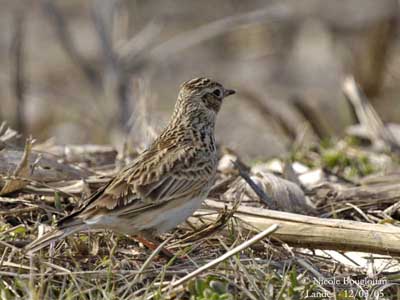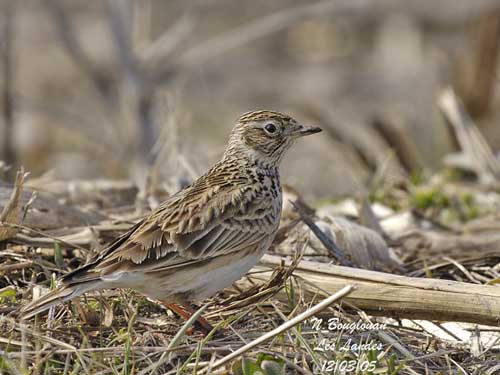
Sky Lark
Alauda arvensis
Passeriforme Order – Alaudidae Family
BIOMETRICS:
Length: 18-19 cm
Wingspan: 32-35 cm
Weight: 40-45 g
DESCRIPTION:
Sky Lark has brown upperparts, heavily streaked blackish-brown. Crown is slightly darker, contrasting with whitish eyebrow.
Underparts are white, except the pale buff breast, streaked with dark brown. Throat is yellowish, finely streaked with dark. Tail is dark, almost black, with spotted white outer feathers. Wings show pale fringes.
PROTECTION / MENACES / STATUS:
Sky Larks clutches are preyed upon by small raptors, foxes and snakes. Adults are captured by humans to sell them for their flesh.
The species is protected, but humans are going on to trap them, and these methods greatly reduce their numbers.
Populations of Sky Larks are also threatened by habitat loss, with changes in agricultural practices and loss of open countries.
Fr: Alouette des champs
All : Feldlerche
Esp : Alondra de Eurasia
Ital: Allodola
Nd: Veldleeuwerik
Russe: Полевой жаворонок
Sd: Sånglärka
Photographs and text by Nicole Bouglouan
Sources :
L’ENCYCLOPEDIE MONDIALE DES OISEAUX - Dr Christopher M. Perrins - BORDAS - ISBN: 2040185607
LE GUIDE ORNITHO par Grant, Mullarney, Svensson, Zetterström - Delachaux Niestle - ISBN: 2603011421
THE COMPLETE BOOK OF BRITISH BIRDS – Written by “Royal Society for the Protection of Birds” experts - Préface de Magnus Magnusson - Michael Cady- Rob Hume Editors - ISBN: 0749509112
THE HANDBOOK OF BIRD IDENTIFICATION FOR EUROPE AND THE WESTERN PALEARCTIC by Mark Beaman, Steve Madge - C.Helm - ISBN: 0713639601
Wikipedia (Wikipedia, The Free Encyclopedia)

Head presents longer feathers on crown, forming a crest. Eyes are dark brown. Bill is relatively short, with upper mandible slightly darker than lower, both horn-coloured. Legs and feet are pale brown. Feet show a rear toe longer than others.
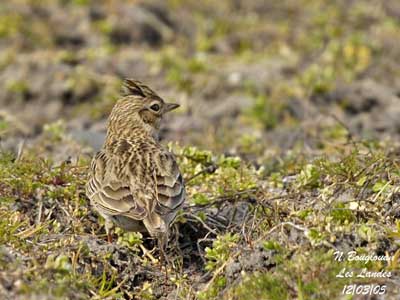
Both sexes are similar in plumage, but male is larger than female.
Juvenile resembles adults. It is heavily mottled with dark and pale buff above, and with whitish scaling.
At hatching, chicks are covered in fine yellowish down.
VOICE: SOUNDS BY XENO-CANTO
Sky Lark male has complex songs. Song is uttered while flying. We can hear loud “trli” or dji” whistles in various pitches. Trills and tremolos are often repeated with different speed, pitch, length and timbre.
When Sky Lark sings on the ground, song is quieter and shorter, with warbling and pauses. The same melodious sequence may last more than one hour.
Sky Lark’s song is unique. Its quality, variety and length inspirited numerous artists, fascinated by these wonderful variations.
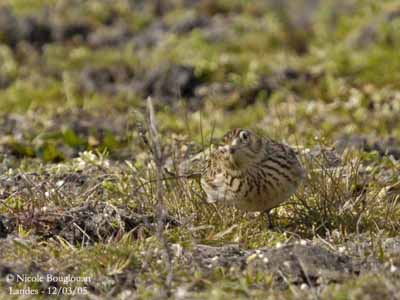
HABITAT:
Sky Lark lives in open country, cultivated areas, marshes, meadows and dunes. They avoid wooded areas but they can be found in forest edges, and also at medium and high elevation in open areas, from 1000 to 2700 metres.
RANGE:
Sky Lark is found in North Africa, Asia and Europe. This species was introduced to Australia, New Zealand, Canada (Vancouver) and Hawaii. Some northern populations migrate southwards, others do not move.
BEHAVIOUR:
Sky Lark often lives on the ground. To feed, it forages on the ground, searching for food by sight, in crouched posture, creeping forwards as it feeds. Its plumage makes it inconspicuous on the ground.
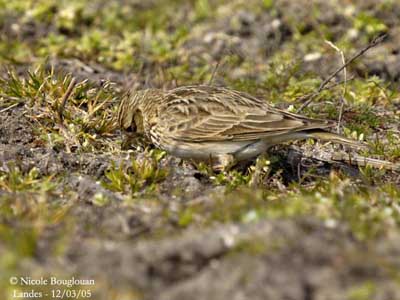
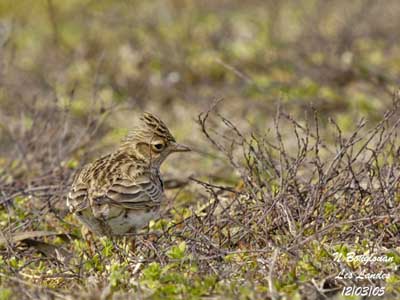
Sky Larks are very gregarious, forming large mixed flocks during migration and winter, with other species such as pipits, finches and buntings.
Most of populations are sedentary, but hard winters see the northern populations migrating southwards, joining the residents of these southern areas. If weather is too cold, Sky Larks die in large numbers.
Sky Larks male sings above or within its territory at about 50 to 60 metres from the nest. Song is used to defend territory and to strengthen pair bonds between mates. Pairs are monogamous and remain together during the breeding season, but if they stay alive after winter, they will be stay together next year. Mates cooperate to raise their young and provide food, with perfect knowing of their territory.
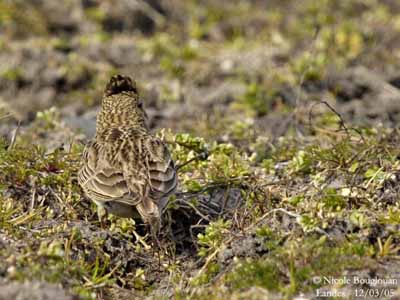
Pairs form in February, leaving large winter flocks to establish territory, generally the same year after year. At this time, males start their flight displays, climbing from the ground in spiral, and singing strongly. Once at high elevation, it descends in spiral, alternating wing beats and glides, always singing. When arrived at some lower elevation, it “falls” to the ground as a stone.
There, it still performs other displays, walking around female with erect crest, dropped wings and fanned tail. Courtship displays reach a peak in March and April, and much more after a strong rain, but we don’t know why!
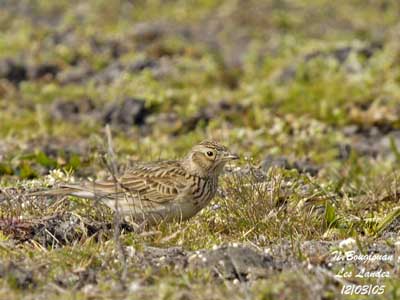
Sky Lark is territorial during breeding season. The bird performs its displays on the ground, with ruffled feathers, erect crest and some threatening actions such as fluttering off the ground with half open wings, and also with aerial displays such as series of upwards glides with some fluttering towards the intruder.
FLIGHT:
Sky Lark flies at low elevation over open country, on short distances, often turning low above the ground, while calling.
On longer distances, flight becomes undulating, but Sky Lark has strong direct flight. During migration, this species may travel on 30 to 80 km per day.
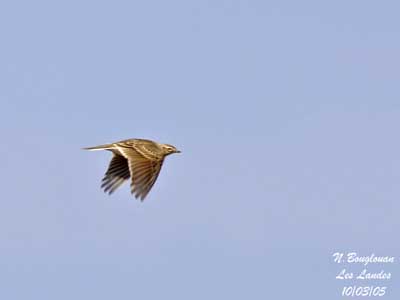
REPRODUCTION:
Sky Lark nests on the ground in shallow depression in meadow or cultivated area, concealed in short grasses, or under scrubs or large leaves. Female builds the nest with grass and dry weeds. Nest is lined with finer plant materials and horsehair or hair.
Female lays 3 to 5 eggs. Colours are varied, according to different pairs and subspecies. Incubation lasts about 11 days, by female, while male continues to fly and sing over the territory.
Chicks are fed by both parents and grow quickly. They leave the nest at about 9 to 10 days after hatching, and they remain in the surrounding vegetation. They fledge 10 days later, at 3 weeks of age. To avoid predators, parents alight at some distance from the nest and they reach the place walking on the ground.
This species produces two broods per year, sometimes three.
DIET:
Sky Lark feeds on insects and larvae, earthworms, and seeds and grain.
